High Road to China Blu-ray Movie
HomeHigh Road to China Blu-ray Movie 
Hen's Tooth Video | 1983 | 105 min | Rated PG | Apr 17, 2012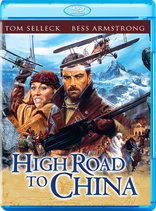
Movie rating
6.6 | / 10 |
Blu-ray rating
| Users | 3.3 | |
| Reviewer | 3.0 | |
| Overall | 3.1 |
Overview
High Road to China (1983)
Patrick O'Malley, a boozing, washed-up aviator, meets his match when he's hired by determined heiress Eve Tozer to find her long lost father. They travel east in O'Malley's WWI biplanes, surviving close calls, combat with warlords and attacks by mysterious enemies along the way. But nothing tops the ongoing battle they have with each other - which leads, inevitably, to romance.
Starring: Tom Selleck, Bess Armstrong, Jack Weston, Wilford Brimley, Robert MorleyDirector: Brian G. Hutton
| War | Uncertain |
| Romance | Uncertain |
| Drama | Uncertain |
| Adventure | Uncertain |
Specifications
Video
Video codec: MPEG-4 AVC
Video resolution: 1080p
Aspect ratio: 1.78:1
Original aspect ratio: 1.85:1
Audio
English: DTS-HD Master Audio 2.0
Subtitles
English
Discs
25GB Blu-ray Disc
Single disc (1 BD)
Playback
Region A (B, C untested)
Review
Rating summary
| Movie | 4.0 | |
| Video | 2.0 | |
| Audio | 3.5 | |
| Extras | 0.5 | |
| Overall | 3.0 |
High Road to China Blu-ray Movie Review
SPEAK! to Us of the Heiress and the Pilot
Reviewed by Michael Reuben March 31, 2012In the years immediately following the success of Raiders of the Lost Ark (as it was then called), a spate of similarly themed pictures appeared, made for less money and of varying quality. One of the best was High Road to China, starring the actor who almost was Indiana Jones, Tom Selleck. According to show business lore, Selleck was prevented from taking what became one of cinema's most iconic roles because of his commitment to the TV series Magnum, P.I. (Not that Magnum isn't iconic; I recently saw Selleck walking in a New York City neighborhood, and as people stopped to look, I heard more than one person say to a companion, "That's Magnum!") Loosely based on a novel of the same name by popular Australian author John Cleary, High Road was an atypical production made outside the Hollywood system with Asian financing. Two screenwriters are credited: Sandra Weintraub, for whom it was the first script to get made, and S. Lee Pogostin, for whom it was the last. Pogostin came from the world of early TV drama, when writing standards were demanding, because scenes had to be well structured and dialogue concise. Weintraub would go on to write for The Young and the Restless. Somehow, this combination of the dramatic and the popularly romantic produced exactly the right mix. The director was former actor Brian G. Hutton, veteran helmer of Kelly's Heroes and Where Eagles Dare. Hutton had learned his craft in the old studio system that no longer existed in America, and he brought to High Road a kind of four-square style that was quickly falling out of fashion. In this case, though, Hutton's approach was ideal for the kind of throwback adventure tale set in the Thirties that the script envisioned. But High Road would be Hutton's last picture. Over the next few years, emerging media conglomerates assembled a new model based on tentpoles, youthful stars and expensive marketing campaigns. Hutton's style had no place in this world. High Road to China has not been available on DVD until now. It is being released simultaneously on DVD and Blu-ray by Hen's Tooth Video, a specialty distributor that has performed a service to fans of this unique and entertaining reminder of an era now past (and, let it be noted, one that did respectable box office). Unfortunately, Hen's Tooth did not have control over the source materials or the transfer to video, and the result on Blu-ray is less than it should be.
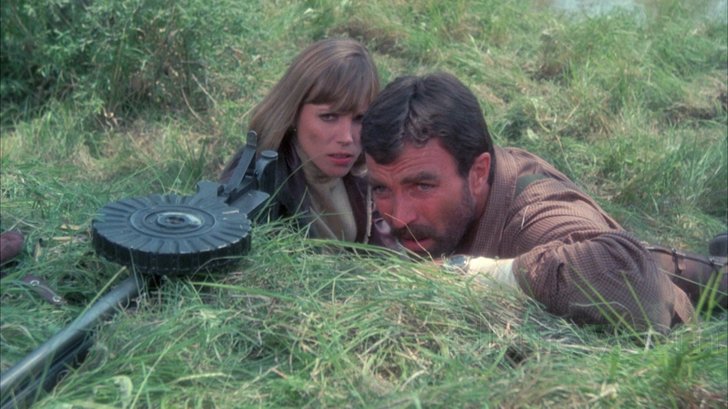
It begins with an heiress, Eve Tozer (Bess Armstrong), living the high life in Thirties Istanbul, dancing and partying with military officers, mostly British. But there's more to Eve than the frivolous flapper she seems on the surface. In the lingo of the era, she's "plucky", a quality that emerges with the arrival of her father's business manager, Charlie Shane, an unassuming man with unexpectedly lethal talents. (The actor, Michael Sheard, was frequently hired to play Hitler, including for the Führer's brief appearance in Indiana Jones and the Last Crusade.) Charlie brings bad news. Eve's father, Bradley Tozer (Wilford Brimley), has been absent for so long on his wanderings in the Far East that his partner, the odious Bentik (Robert Morley), is about to have him declared legally dead so that he can seize Tozer's half of their company. Eve has just twelve days to find her errant dad and get him into a British courtroom. The last report placed Bradley Tozer in Afghanistan, which means that Eve needs to charter a plane. This brings her to former World War I flyer (and reputed war hero) Patrick O'Malley (Selleck), who runs a sort of flying school outside of town. Eve is referred to O'Malley by Lina, the wife of a British officer who asks that Eve be discreet because her "lessons" never involved leaving the ground in an airplane. (Trivia note: Lina is played by Lynda La Plante, who would go on to create Prime Suspect for Helen Mirren.) O'Malley turns out to be a boozer and a loafer—almost a caricature of one of Hemingway's "lost generation" types—but he does have two working biplanes and an ace mechanic called "Struts" (Jack Weston). After much haggling over price, he agrees to help Eve find her father. Bentik has not been idle, though. Back in England, he keeps ordering his chief underling, Wedgeworth (Timothy Bateson), to dispatch "agents" to thwart Eve. They almost prevent Eve from leaving with O'Malley, but the self-absorbed pilot thinks the thugs with guns were sent by some jealous husband that he offended. They'll be halfway through their adventure before O'Malley figures out who's the real target of all the violence they keep attracting. Since the title is High Road to China, it's no spoiler to reveal that Bradley Tozer isn't in Afghanistan. That's just the first stop on a trip that covers India, Nepal and, eventually, a tiny Chinese province. Memorable encounters await, including with the Afghan warlord Suleman Khan (Brian Blessed, deliciously over the top), who's like a parody of the Afghan fighters with whom we've become all too familiar in the present day, especially in his neanderthal approach to women. But the real story of High Road is the endless sparring match (or should we call it what it is and say "foreplay"?) between Eve and O'Malley. Both contemporary in its idiom and old-fashioned in the attention devoted to it (at the expense of chase scenes and effects, for which the budget was small by Hollywood standards), the constant bickering between these two is what makes the film worth watching (and re-watching). Selleck and Armstrong have wonderful onscreen chemistry, and it's a shame no one ever thought to pair them again. If you're looking for a swashbuckling adventure story, you can do better, but if you're interested in a brightly entertaining comedy with a touch of romance and a streak of adventure (and, near the end, a good set of real explosions with no CG enhancements), you can't do much better.
High Road to China Blu-ray Movie, Video Quality 
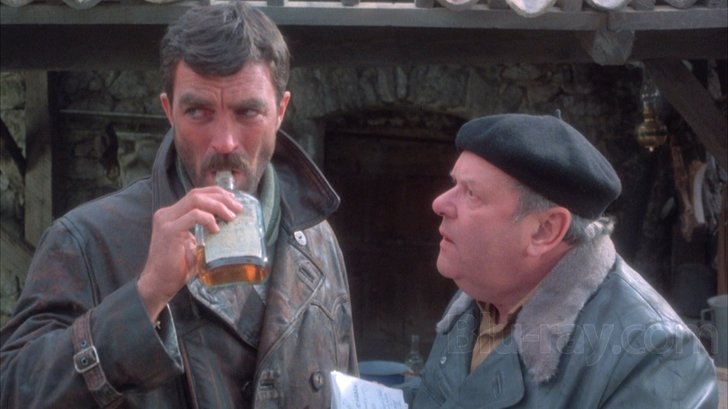
After so long a wait, I would like to report that the image on Hen's Tooth's 1080p, AVC-encoded Blu-ray is a triumph, but I can't. I have been advised by Hen's Tooth that they were supplied with a hi-def transfer performed by the film's rightsholder from the original camera negative (or "OCN"); so at least Hen's Tooth can't be blamed for the pervasive lack of detail that afflicts the entire presentation and that no transfer from an OCN should display. I'm not talking about the somewhat muddy quality of the image when the film starts. That's a function of the credit sequence, which, consistent with the standard of the time, was produced by optical superimposition that inevitably degraded the image. The picture quality changes significantly after the shot that includes Hutton's director's credit, which appears at 4:42. But while the image becomes noticeably cleaner, it never at any point displays the level of detail, in close-ups, medium or long shots, of which film is capable and that Blu-ray can readily reproduce. Now before anyone runs off screaming "DNR" (a grossly abused and misused term on internet forums), let it be noted that film grain is visible and plentiful in this transfer. Indeed, the occasional night scenes (e.g., when Eve and Charlie first meet up with O'Malley and Struts) can be quite grainy. No, this appears to be a more fundamental issue with black levels and contrast settings, because it is hard not to notice just how bright everything in this image is at all times. There are no deep blacks or shadows, and as anyone who has ever performed the most basic calibration on a TV should know, an emphasis on brightness above all is the enemy of detail, which gets washed away by an excess of white. (Fleshtones also suffer from excess redness, but this could easily be a side effect of overbrightening.) Indeed, this transfer strikes me as one prepared by technicians with their eye on the DVD market, as if the loss of detail didn't concern them, because they knew it would be lost in the downconversion anyway. What remains is certainly better than DVD, but we have long since passed the point with Blu-ray where "better than DVD" is an acceptable standard. My initial reaction on viewing the Blu-ray of High Road to China was that it must have come from a second or third generation print, which might explain the loss of detail. Having learned that it came from an OCN transfer, I can only shake my head in disappointment at what might have been. (And if the explanation turns out to be that the OCN had deteriorated past the point where it could support an acceptable transfer, which does happen, then someone in a position of authority should have made the decision to use a superior alternative.) With respect to the aspect ratio, for a long time IMDb listed High Road to China with an AR of 2.35:1, which was wrong. I suspect the confusion arose from the fact that the cameras and lenses were supplied by Technovision, a French company that was also known for a widescreen process of the same name. As with Panavision (which subsequently acquired Technovision), people often confused the company with the process. Currently, IMDb lists the film's AR as 1.78:1, presumably relying on the Blu-ray. That, too, is inaccurate, because it's not an AR for theatrical exhibition. High Road to China was released theatrically at 1.85:1, and Hen's Tooth is following the Warner practice of releasing such films on video at 1.78:1, which is the official AR of HDTV. Whether this involves cropping a few pixels or adding a few (by "opening up the matte") is impossible to say without definitive information on the OCN. High Road to China was shot in Europe by a British cinematographer (Ronnie Taylor) and a mostly European crew; if it was shot with a "hard" matte, it was most likely at 1.66:1, which would have allowed room to open up the image for this Blu-ray. Certainly nothing about the Blu-ray looked cramped or cut off.
High Road to China Blu-ray Movie, Audio Quality 

The film's original soundtrack is reproduced as DTS-HD MA 2.0, with both tracks containing the same mono track. Mono releases remained common thirty years ago, if the film's budget was limited, especially since many movie theaters had yet to "upgrade" to stereo. (Yes, it's true.) Still, the Blu-ray's track has fine fidelity, with excellent reproduction of dialogue and sufficient dynamic range to bring out John Barry's beautiful score. Barry wrote relatively fewer cues for this film than for some of the others for which he composed soundtracks, but his main theme effectively establishes the tone, and it strongly anticipates his Oscar-winning score for Out of Africa two years later. There's a dogfight sequence that shows off the work of the sound editors, even if all the sound stays in front, and there's enough bass extension in some of the pyrotechnics to engage the subwoofer (assuming one's system is properly configured). Yes, Virginia, mono soundtracks can tell a good story
High Road to China Blu-ray Movie, Special Features and Extras 
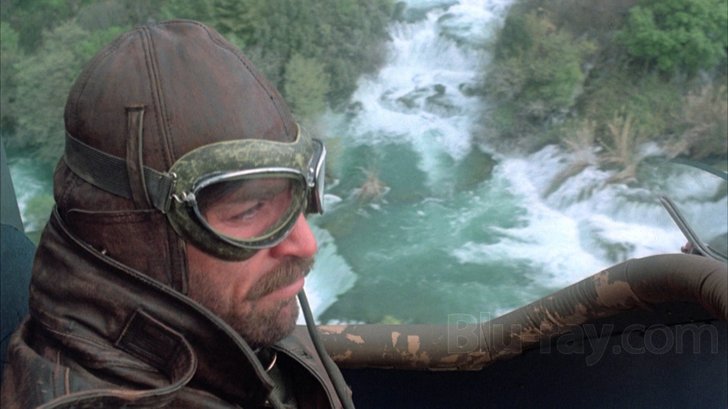
- Trailer (HD, 1080p; 1.78:1; 1:59): It's a good trailer, and the image even shows superior contrast compared to the same footage in the film.
High Road to China Blu-ray Movie, Overall Score and Recommendation 
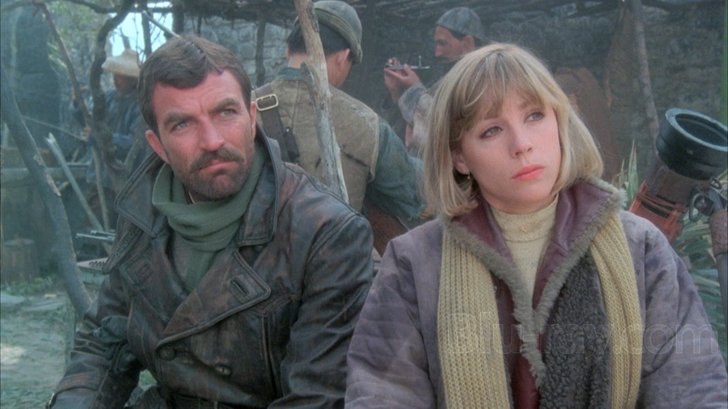
Fans of High Road to China who have waited this long will no doubt be disappointed by this review (and if not by the review, then by the screenshots). As a fellow fan, I share the disappointment. The usual reaction to such a release is to call for a boycott until it's reissued and "done right", but in this case I think that would be counter-productive. Hen's Tooth Video is a tiny operation, not a multi-media conglomerate, and it has made an admirable effort to bring this neglected gem to the home video market when no one else was willing to do so. High Road isn't going to be reissued anytime soon, and boycotting it will simply discourage future efforts by such independent distributors. The more productive route is to rent or buy the disc and write Hen's Tooth a polite (polite!) letter emphasizing what they should do better next time. This is only their third outing as Blu-ray publishers, and if the experts here don't tell them, who will? That's as close as I can come to a recommendation of the disc. The film is terrific.
Similar titles
Similar titles you might also like

Tobruk
1967

Merrill's Marauders
Warner Archive Collection
1962

The Buccaneer
1958

The Conqueror
1956

Flying Leathernecks
Warner Archive Collection
1951

Never So Few
1959

The Fighting Seabees
1944

Dark of the Sun
The Mercenaries
1968

Objective, Burma!
Warner Archive Collection
1945

Ice Cold in Alex
1958

Retreat, Hell!
1952

Khartoum
1966

The Dogs of War
New 2K Restoration
1980

They Were Expendable
Warner Archive Collection
1945

Sands of Iwo Jima
4K Restoration
1949

Go Tell the Spartans
1978

The Sound Barrier
Breaking the Sound Barrier
1952

Thunder in the East
1952

The African Queen
1951

Raid on Rommel
1971